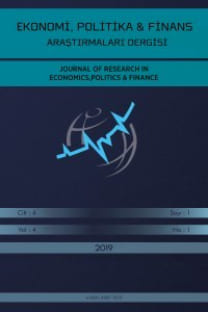Kayıt Dışı Ekonomi Finansal Sektörün Gelişimini Kısıtlıyor mu?
Kayıt Dışı Ekonomi, Panel Veri Analizi, Finansal Sektör
Does Shadow Economy Restrain Financial Sector Development?
Shadow Economy, Panel Data Analysis, Financial Sector.,
___
- Abu-Lila, Z., Ajlouni, S. and Ghazo, A. (2021). Nonlinearity between financial development and the shadow economy: Evidence from Jordan. Accounting, 7(5), 1049-1054. doi:10.5267/j.ac.2021.3.004
- Aga, G.A. and Reilly, B. (2011). Access to credit and informality among micro and small enterprises in Ethiopia. International Review of Applied Economics, 25(3), 313-329. https://doi.org/10.1080/02692171.2010.498417
- Ajide, F.M. (2021). Shadow economy in Africa: How relevant is financial inclusion? Journal of Financial Regulation and Compliance, 29(3), 297-316. https://doi.org/10.1108/JFRC-10-2020-0095
- Bayar, Y. ve Ozturk, O.F. (2016). Financial development and shadow economy in European Union transition economies. Managing Global Transitions: International Research Journal, 14(2). Retrieved from https://www.fm-kp.si/
- Berdiev, A.N. and Saunoris, J.W. (2016). Financial development and the shadow economy: A panel VAR analysis. Economic Modelling, 57, 197-207. https://doi.org/10.1016/j.econmod.2016.03.028
- Bittencourt, M., Gupta, R. and Stander, L. (2014). Tax evasion, financial development and inflation: Theory and empirical evidence. Journal of Banking & Finance, 41, 194–208. https://doi.org/10.1016/j.jbankfin.2014.01.009
- Blackburn, K., Bose, N. and Capasso, S. (2012). Tax evasion, the shadow economy and financial development. Journal of Economic Behavior & Organization, 83, 243–53. https://doi.org/10.1016/j.jebo.2012.05.019
- Bose, N., Capasso, S. and Wurm, M.A. (2012). The impact of banking development on the size of shadow economies. Journal of Economic Studies, 39 (6), 620–38. doi:10.1108/01443581211274584
- Breusch, T.S. and Pagan, A.R. (1980). The Lagrange multiplier test and its applications to model specification tests in econometrics. Review of Economic Studies, 47, 239-53. https://doi.org/10.2307/2297111
- Canh, N.P. and Thanh, S.D. (2020). Financial development and the shadow economy: A multi-dimensional analysis. Economic Analysis and Policy, 67, 37-54. https://doi.org/10.1016/j.eap.2020.05.002
- Capasso, S. and Jappelli, T. (2013). Financial development and the shadow economy. Journal of Development Economics, 101, 167–78. https://doi.org/10.1016/j.jdeveco.2012.10.005
- Dabla‐Norris, E.R.A. and Feltenstein, A. (2005). The underground economy and its macroeconomic consequences. The Journal of Policy Reform, 8(2), 153-174. https://doi.org/10.1080/13841280500086388
- Din, B.H. (2016). Estimating the determinants of shadow economy in Malaysia. Geografia, 12(5). Retrieved from http://www.ukm.edu.my/
- Elgin, C. and Uras, B.R. (2013). Is informality a barrier to financial development? SERIEs, 4(3), 309-331. doi:10.1007/s13209-012-0092-9
- Ellul, A., Jappelli, T., Pagano, M. and Panunzi, F. (2012). Transparency, tax pressure and access to finance (CEPR Discussion Papers No. 8939). https://doi.org/10.1093/rof/rfv005
- Gatti, R. and Honorati, M. (2008). Informality among formal firms: Firm-level, cross-country evidence on tax compliance and access to credit (World Bank Policy Research Working Paper No. 4476). Retrieved from https://papers.ssrn.com/sol3/papers.cfm?abstract_id=1083904
- Gharleghi, B. and Jahanshahi, A.A. (2020). The shadow economy and sustainable development: The role of financial development. Journal of Public Affairs, 20(3), 2099. https://doi.org/10.1002/pa.2099
- GİB. (2009). Kayıt dışı ekonomiyle mücadele stratejisi eylem planı (2008 – 2010). Erişim adresi: http://www.gib.gov.tr/fileadmin/beyannamerehberi/Kayit_disi_2009tr.pdf.
- Gobbi, G. and Zizza. R. (2007). Does the underground economy hold back financial deepening? Evidence from the Italian credit market (CEP Discussion Paper No. 789). Retrieved from http://eprints.lse.ac.uk/19731/1/Does_the_Underground_Economy_Hold_Back_Financial_Deepening_Evidence_from_the_Italian_Credit_Market.pdf
- Gylys, P. (2005). Economy, anti-economy, underground economy: Conceptual and terminological problems. Ekonomika, 72, 1–11. Retrieved from https://etalpykla.lituanistikadb.lt/
- Hajilee, M. and Niroomand, F. (2021). Is there an asymmetric link between the shadow economy and the financial depth of emerging market economies? The Journal of Economic Asymmetries, 23, e00193. https://doi.org/10.1016/j.jeca.2020.e00193
- Mar'i, M. and Cavusoglu, B. (2021). Shadow economy, economic growth and financial development. Research Square, Advance online publication. https://doi.org/10.21203/rs.3.rs-150324/v1
- Önder, İ. (2001). Kayıt dışı ekonomi ve vergileme. İstanbul Üniversitesi Siyasal Bilgiler Fakültesi Dergisi, 23-24, 241-254. Erişim adresi: https://dergipark.org.tr/tr/pub/siyasal
- Pant, M., Chowdhury, P.R. and Singh, G. (2009). Financial intermediation and employment. Review of Market Integration, 1, 61–82. https://doi.org/10.1177/097492920900100104
- Pesaran, M.H. (2003). General diagnostic tests for cross-sectional dependence in panels (CESifo Working Paper Series No. 1229). Retrieved from https://doi.org/10.1007/s00181-020-01875-7
- Pesaran, M.H. (2006). Estimation and inference in large heterogeneous panels with a multifactor error structure. Econometrica, 74(4), 967-1012. https://doi.org/10.1111/j.1468-0262.2006.00692.x
- Pesaran, M.H. (2007). A simple panel root test in the presence of cross section dependence. Journal of Applied Econometrics, 22, 265-312. https://doi.org/10.1002/jae.951
- Schneider, F. (2005). Shadow economies around the world: What do we really know? European Journal of Political Economy, 21(3), 598-642. https://doi.org/10.1016/j.ejpoleco.2004.10.002
- Schneider, F. (2012). The shadow economy and work in the shadow: What do we (not) know? (IZA Discussion Paper No. 6423). Retrieved from http://dx.doi.org/10.2139/ssrn.2031951
- Schneider, F. and Enste, D. H. (2000). Shadow economies: Size, causes, and consequences. Journal of Economic Literature, 38(1), 77-114. doi:10.1257/jel.38.1.77
- Singh, A., Jain-Chandra, S. and Mohommad, A. (2012). Out of the shadows. Finance & Development, 49(2), 42–45. https://doi.org/10.5089/9781451922202.022
- Teobaldelli, D. (2011). Federalism and the shadow economy. Public Choice, 146(3), 269-289. doi:10.1007/s11127-009-9590-0
- Williams, C.C. and Schneider, F. (2013). The shadow economy. London: Institute of Economic Affairs.
- Yerdelen Tatoğlu, F. (2020). Panel zaman serileri analizi Stata uygulamalı (3.bs.) İstanbul: Beta Yayıncılık.
- Yayın Aralığı: Yılda 4 Sayı
- Başlangıç: 2016
- Yayıncı: Ersan ERSOY
Birleşme ve Satın Alma Haberlerinin Borsa Getirisi Üzerine Etkisi: 2005-2017 Borsa İstanbul Örneği
Nihal Atsız Türkçülüğü ve Milliyetçi Hareketin Yol Ayrımı
TVP-VAR Tabanlı CARR Oynaklık Bağlantılılığı: Rusya-Ukrayna Çatışmasından Kanıtlar
Umut Can ÖZTÜRK, Hüseyin Başar ÖNEM
Kayıt Dışı Ekonomi Finansal Sektörün Gelişimini Kısıtlıyor mu?
Dow Jones Sukuk Endeksiyle Seçilmiş İslami Hisse Senedi Endeksleri Arasındaki Volatilite Etkileşimi
Müge SAĞLAM BEZGİN, Emine KARAÇAYIR
Yüksek Hava Kirliliği Yaşanan Ülkelerde Doğumda Yaşam Beklentisi ve Çevresel Bozulma Bağlantısı
Türkiye’nin Gürcistan İle Dış Ticaretinde Rekabet Gücü: Balassa Akü Endeksi Analizi
İktisat Tarihinde Yöntem Kayması: Yeni İktisat Tarihi Akımına Eleştirel Bir Bakış
